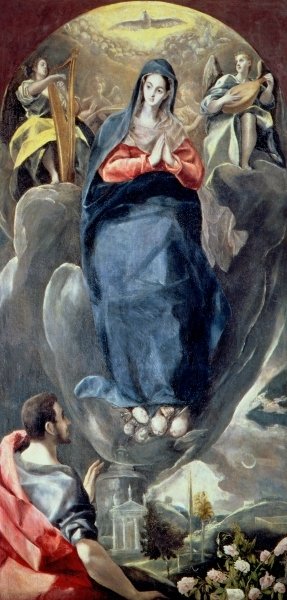 To view the artwork on a smart board click here.
To view the artwork on a smart board click here.
Part Three of the Compendium is entitled ‘Life in Christ’, and Section One introduces us to man’s authentic vocation, which is Life in the Holy Spirit. The painting chosen to illustrate this Section is El Greco’s St John contemplates the Immaculate Conception, presently to be found in the Museum of Santa Cruz (Holy Cross), Toledo, Spain. El Greco (1541-1614) made this painting during his period of prolific activity between 1607 and his death in 1614. It is a particularly appropriate choice, for as the Compendium puts it: ‘Mary, the Panhagia, (all holy), is the masterpiece of the Holy Spirit. (Panhagion). Her existence from her Immaculate Conception to her glorious Assumption into heaven, is completely sustained by the love of God. The Spirit of the Love of the Father and the Son makes Mary a new creature, the new Eve.’
Tradition
Although the doctrine of the Immaculate Conception was not officially promulgated until 1854 (in the Ineffabilis Deus of Pius IX), it has long been part of the Tradition of the Church. The feast of the Immaculate Conception was instituted by Pope Sextus IV in 1477, and in its decree on Original Sin in 1546, the Council of Trent specifically exempted the Virgin from any stain of Original Sin.
An early painting of the Immaculate Conception, made in 1492 by Carlo Crivelli, hangs in the National Gallery, London, and seventeenth century Spain produced a profusion of ‘Immaculadas’ by artists such as Pacheco, Velasquez, Murillo and Zurbaran. El Greco, a Cretan Greek who came to Spain via Titian’s Venice, thoroughly absorbed the Spanish spirituality of the Counter Reformation. His magnificent paintings of the Immaculate Conception effectively became templates or prototypes for those later Spanish artists.
This particular interpretation is especially interesting for its many allusions to the Litany of Loreto. This Litany had only been approved and indulgenced by Pope Sixtus IV as recently as 1587, and again by Pope Clement VIII in 1601, so its impact must have been fresh and powerful in El Greco’s imagination at that time, and influenced his interpretation of the theme.
The painting
The actual painting is large in size as it was part of an altarpiece. It measures some 236cms by 118cms (8ft by 4ft). It is divided horizontally into three tiers. In the lowest of these, the Evangelist occupies the left side. He looks up in awe at the Virgin, his hand raised in wonder. To his right side we see a mass of symbols. Centrally placed at the Virgin’s feet is the Ark of the Covenant. In the Temple, the Ark was set directly below the Mercy Seat in the Holy of Holies. It contained the stones on which were written the Words of the Law, a sample of manna and Aaron’s flowering rod. Mary, the new Ark of the Covenant, bore the Word of God, whose flesh flowered in her womb to become our Eucharistic Manna. The roses in the bottom right hand corner point to Mary as the Mystical Rose. In the original setting of the painting, they would have seemed to be growing out of the altar itself. The Evangelist’s spiritual excitement is emphasised by the appearance of the sun and the moon shining simultaneously (see Rev 12:1). Sunlight bursts through a break in the clouds to reveal a palm tree, symbol of Justice (Ps 92:12), and to remind us that Mary is the Mirror of Justice. Next to it is a cypress, the evergreen leaves of which signify eternal life, and then an olive tree, symbol of Peace (Gen 8:11), but also a prefiguring of Gethsemane.
The great central space of the painting is filled with a beautiful image of the Virgin. She wears a red tunic, symbol of her humanity, but she is swathed in a voluminous blue cloak which represents that all-enveloping fullness of Grace to which the Angel Gabriel attested (Luke 1:28). She is floating in a diaphanous, womb-like cloud, which both filters light and also reflects the blue colouring of her cloak. Beneath her feet are putti, and on each shoulder we see musical angels with harp and lyre. Above her head, in the uppermost tier of the painting, she is crowned with the Divine Love of the Holy Spirit, represented by a Dove hovering in a golden halo. Between the Dove and the Virgin’s head, countless putti sing her praises. The whole thrust of her elongated figure carries our eyes upwards from the Evangelist below, through the Virgin to the Holy Spirit above. Mary herself emphasises this movement, for her gaze is directed at St John, and her hands point us upwards towards Heaven.
El Greco’s painting gives us a wonderful vision of the Mystery of the Immaculate Conception, which is perfectly summed up in the Compendium:
‘Mary’s heart and mind are intent upon the adoration of and obedience to the heavenly Father. She is his beloved daughter and she is also dedicated to the acceptance and service of the Son, whose mother and disciple she is. Her soul is likewise intent upon her surrender to and co-operation with the Holy Spirit, for whom she is a treasured sanctuary.’
This article is originally found on page 21 of the printed edition.
Art credit: The Immaculate Conception Contemplated by St. John the Evangelist, El Greco (1441-1641), Museo de Santa Cruz, Toledo, Spain/The Bridgeman Art Library.
This article is from The Sower and may be copied for catechetical purposes only. It may not be reprinted in another published work without the permission of Maryvale Institute. Contact [email protected]

















